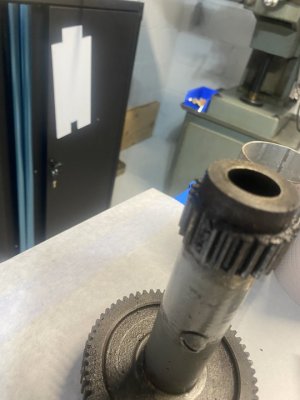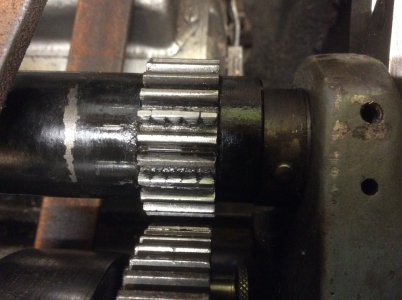Gear pitch would affect the following description to an extent. My machine has 16 DP gears on most of the train. I'm not sure what the back gears are. Further, I have seen this done on larger gears but my only personal experience is on small gears, 28 DP and smaller. On top of that, my application is for lighter loads. I don't know how it would stand up to heavy loads.
This instruction is a purely mechanical repair. No torch work or welding is used. The first step on removal of the gear is examination of the gear for cracks in the web or hub of the gear. If there is any anomoly, I immediately withdraw from the conversation. The first step is to mill down the tooth a 'fuzz' below its' root. If a milling machine is available, it likely would make a smoother path. But hand filing is sort of a 'fall back, old standby' situation. The gear is drilled and tapped for an appropriate screw size. Three or four screws, or more depending on width. For my 16 DP gears, I would use a 3/16 screw, Nr 10-24 or 32. As much a matter of what screws I had on hand, 1/8 inch or 3-3.5mm would do as well. Hardened or high strength screws are preferable.
The metal that the gear is made of would determine the best metal for repair. For a cast iron or brass gear, I would use brass. For a ZAMAK gear, aluminium would be a better choice. A steel gear would be best built back with mild steel. Make a rectangular piece like key stock to fit the milled flat. The flat can be milled or filed. I'm pretty good for patience and a fair hand at filing. That would be my choice in general.
Attach the key stock with the screws tapped into the gear. Final fitting of the keystock must be done carefully, assuring a solid seat. A plastic steel such as JB Weld would make a smoother fit, but is not vital. Then filing the tooth profile to match the existing gear. There is room for small mistakes, provided the repair tooth has the overall profile desired. If a milling machine is available, a profile cutter will give better results. But hand shaping (filing) is the way my small gears are done.
As well as watching underway repairs in the engine room in times long past. The ship didn't have a milling machine, it was all hand work. We were at sea for 6 months at a time, any repairs were done under weigh. The screw heads will be distorted by the filing. Make sure they are tight and then forget them. Just an integral part of the repair, they will be a 'total loss' as far as removing them.
.


